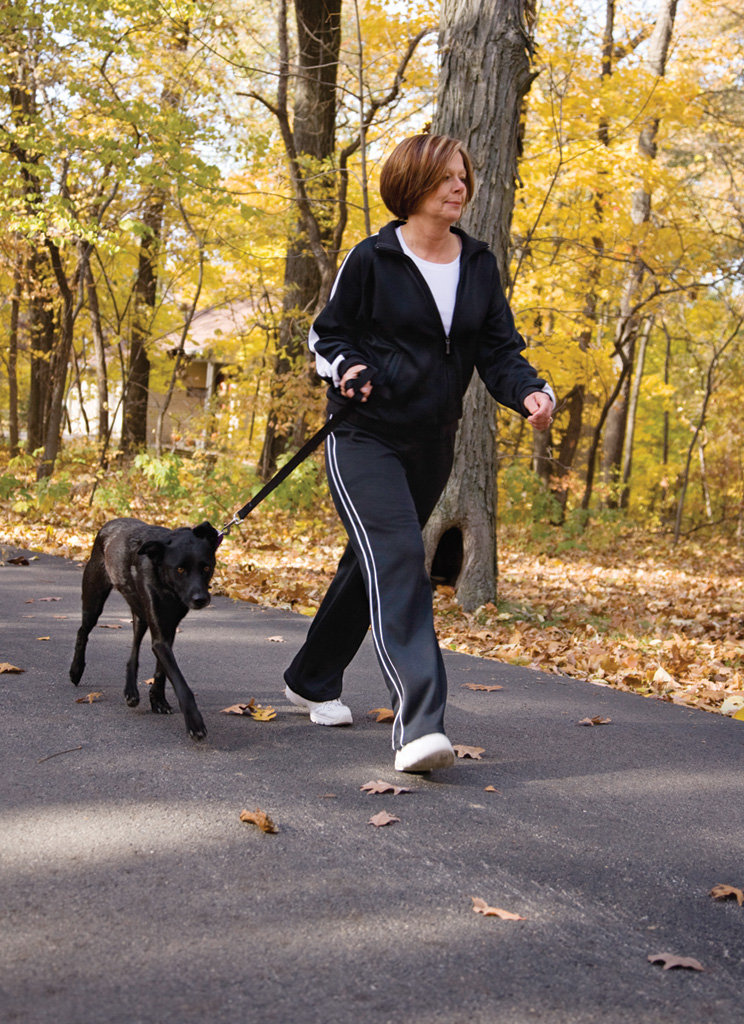By Joe Stein and Dr. Heather Baginski
A few days ago a client was talking about how hot it’s been recently and said we’re not even in the “dog days of summer yet.” I checked the Old Farmer’s Almanac and found that the 40 days between July 3 and Aug. 11, 2016 are indeed the dog days of summer. This time of year has always had a bad rap: In 1813 author John Brady, in his Clavis Calendaria, wrote about the dog days saying “…the sea boiled, the wine turned sour, dogs grew mad, and all other creatures became languid; causing to man, among other diseases, burning fevers, hysterics, and phrensies.”
Exercising outdoors with your dog would seem especially dangerous during this time. But don’t despair, you and Fido still can enjoy the summer. Just as you would not begin an exercise program without a consultation from your doctor, a trip to the veterinarian is the first step in developing a plan for your dog. Medications, allergies and health histories need to be reviewed.
Some general rules: Older dogs cannot run or play the way younger dogs do. Toy breeds and dogs with short legs and elongated spines were not designed for running, although they may be slow but steady hunters. When exercising puppies and young dogs of giant breeds such as Saint Bernard, Great Dane and Irish Wolfhound, care must be given not to stress the joints by playing too hard. Many factors need to be considered when exercising with your dog, including his/her fitness level, weight, outside temperature, coat color and conformation. Dogs with darker coats and those which are overweight have increased risk factors for heat exhaustion and heat stroke.
By the way, dogs feel the heat 10 degrees warmer than you do because they only “sweat” through their tongue and on the pads on their feet. Brachycephalic dogs, those with short noses and pushed-in faces, are at greater risk of heat stroke than other dogs. Boxers, Puggles, Boston Terriers, Pugs and Bull Dogs, etc. often have respiratory ailments that prevent sufficient air to move over their tongues for sufficient cooling.
According to Dr. Heather Baginski, a board-certified veterinary surgeon of Red Bank Veterinary Hospital, “Whatever outdoor exercise you do, there are some simple guidelines to follow in order to help ensure you and your canine companion stay safe and have fun. Her top ten tips are:
- If you are beginning an exercise program, start slowly and build up gradually. If your pet is showing signs of reluctance or lameness towards the end, then next time you should shorten the distance. Never leave your dog in a car. If your dog is “done,” take him home.
- Keep your dog on a leash. This enables you to remain in control in the presence of cars, people, and other pets.
- When possible, keep your dog off hot pavement if going long distances. The pavement can become extremely hot and even burn their pads. Check your dog’s paws to see that there are no thorns, burrs, gum or chemicals on or between the pads.
- Wear reflective gear when it is dark … both of you.
- Keep a couple of plastic bags handy, as exercise can stimulate your dog’s need to eliminate.
- Check for ticks and fleas after spending time in a wooded area.
- If your dog has been diagnosed with arthritis, or he/she is older, the best types of exercises are low-impact activities such as walking and swimming. These help to support flexibility. High-impact activities such as running and chasing balls or Frisbees will likely worsen their signs the next day.
- Be alert for signs of overexertion and heat stroke. If your dog exhibits rapid breathing, salivation, tremors or seizures, vomiting, or collapses, move your dog in the shade, cool him down with wet towels, and get them to the vet immediately. Avoid using ice or ice water.
9. If your pet is overweight, is a brachycephalic breed, (like Pugs with a smushed-in noses) or has respiratory or cardiovascular disease, it is never recommended to have them outside in the middle of a summer day. These dogs should only be exercised outside in the morning or late afternoon hours.
10. Have water available for both you and your pet.
11. Dogs like routine. Be consistent so that you and your four-legged friend develop a mutual exercise habit.
This sure sounds a whole lot better than burning fevers, souring wine and boiling seas, doesn’t it? So, how do you and your dog enjoy the summer together? Shoot me an email … I’d love to know.
Joe Stein, B.S., M.B.A., is an empowerment speaker, certified personal trainer, health and lifestyle coach and owner of Renaissance Fitness & Wellness. He is the author of Leave the Cannoli Take the Weights: Practical Guidance on Eating, Exercise and Empowerment. Call 732-345-5151 or email at [email protected] with questions about fitness or speaking engagements. Dr. Heather Baginski, D.V.M., D.A.C.V.S. of Red Bank Veterinary Hospital can be reached at 732-747-3636 or through www.RBVH.net.

